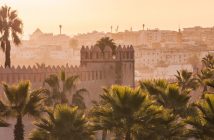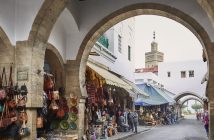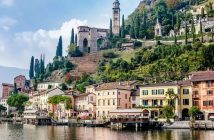Like Lucy Honeychurch and her overbearing chaperone Charlotte Bartlett in E.M. Forster’s famous novel, we had been promised a room with a view. After a stomach-churning journey through Sorrento’s scandalously narrow streets, on arrival at the shaded sanctuary of the Grand Hotel Excelsior Vittoria, we were escorted to a small dark room where only a sliver of sea was visible if you craned your neck out of the window far enough. My heart crumpled. The receptionist left and I sat on the sofa staring wistfully at the welcome platter that included hunks of Parmesan and a scooter crafted from white chocolate.
Keen to remedy the situation, I phoned the front desk and explained the promise of a room with a view, and how dramatically a beautiful view would transform my stay. After a nervous wait, we were ushered out of the dark yellow room along the corridor. My heart pounded as the clerk fiddled with the key, unsure of what awaited us behind the door but resigned to accepting whatever fate we’d been dealt.
The gods were on our side. Our new room was three times the size of the original with an enormous balcony boasting breathtaking views of the bay of Naples. Vesuvius stood mistily in the distance. I wanted to weep with joy. Struggling to contain my excitement I thanked the receptionist profusely and let out a squeal of delight when she left, while my mother devoured the white chocolate Vespa, peeved that she’d had to refrain from the first welcome platter. Flooded with natural light, the white room with hints of mint and powder blue was stately in stature, with its arched ceiling, crystal chandeliers and ornate gold bedpost.

Having been owned an run by the art loving Fiorentino family since it opened in 1834, the five-star hotel is the grande dame of Sorrento. Perched elegantly on a cliff near the Piazza Tasso, on entering its flower filled grounds and descending a stone staircase into its airy atrium offering views out to sea, it feels as though time has been wound back a century. Adding to its individuality, all 85 rooms are different. Waiters wear white tuxedos and ooze the effortless charm unique to the Italians. A sense of history looms large – the ruins of Roman Emperor Augustus’ villa are said to lie beneath the property, which has played host to everyone from Oscar Wilde and Richard Wagner to Catherine the Great and Queen Victoria. Princess Margaret must have made an impression as she had a suite named in her honour.
A home from home for the well-heeled, the Excelsior boasts some of the finest interiors I’ve encountered in a hotel, from its trellised Art Nouveau winter garden and Belle Époque music room, to its wonderfully over the top breakfast room complete with a frescoed ceiling cascading with rosy-cheeked cherubs. For an aesthete, ambling around the hotel is an utter joy. You could get intoxicated off the interiors alone, which prove so alluring, the prospect of leaving to explore Sorrento feels like a chore. I imagine the regulars rarely do. Nestled among five acres of gardens dotted with olive, orange and lemon groves, and the occasional hammock, there’s a real sense of privacy and secluded luxury about the place.
After a stroll around sunny Sorrento through cobbled streets lined with ice cream parlours, buzzy piazzas and rowdy pizzerias, as the sun began its descent, my mum and I weaved our way back to the hotel to drink in the sunset from our private balcony, which was bathed in golden light upon our return as if on cue. Enjoying the sweetness of doing nothing, we sat watching the bobbing boats below as broad brushstrokes of pink began to stain the sky.

Dressing for dinner, on arrival at the al fresco Terraza Bosquet restaurant, we were kindly, if somewhat comically, escorted to the most romantic table in the house overlooking the bay in a private cove warmed by fire heaters, the soft sounds of a grand piano floating down from the music room above. Beginning as any good meal should with a thirst quenching glass of Champagne and an introduction to the delights of buffalo butter, a feast followed that showcased Sorrento’s specialty: seafood in a variety of guises, from saline sea bream carpaccio served on a silver spoon, to razor clams hiding in chubby tubes of pasta flecked with paper-thin sheets of purple potato. To pair with it, our sommelier poured us a zippy apricot and peached-laced Greco di Tufo from nearby Campania.
Executive chef Luigi Tramontano’s most triumphant dish came from the land rather than the sea in the form of a mushroom medley that included a crunchy croquette and unctuous mushroom ice cream that sounds so wrong but tasted so right, particularly when paired with an earthy 2011 Barolo that sang with notes of tar and roses. Our stay was all too brief. After a languorous breakfast involving almond croissants and countless coffees in the angelic Vittoria dining room, a great glass elevator on the terrace whisked us down to the port below where we boarded a ferry filled with excitable teens bound for Capri.

Our dwelling was the salmon pink Punta Tragara, described by iconic Swiss-French architect Le Corbusier, who drew up the plans for the place, as “a kind of architectural bloom, an extension of the rock, an offspring of the island”. We were told to look out for a Punta Tragara representative after taking a cable car to the top of the island. Searching for our man among the throng, we joked that it might be the disheveled guy standing next to what looked like a dumper truck with an ornate chair inside its cage at the back as if awaiting Marie Antoinette.
Laughing off the suggestion, when no other likely chaperones emerged after 10 minutes it became apparent that we were to journey to the five-star hotel in the electric luggage carrier. My mother nabbed the pretty seat at the back and sat regally upon her throne like a visiting dignitary. I drew the short straw and sat up front in the doorless vehicle beside the driver who treated the narrow roads like an assault course, hurtling around corners with maniacal glee and nearly flinging me off the cliff edge in the process. Zooming through the streets, astonished passers-by swerved out of our way like characters in a video game.

Adrenaline surging through our veins, on arrival we were shown to a suite that overlooked the famous Faraglioni rocks immortalised by David Gandy who frolicked among them in his pants in Mario Testino’s memorable advert for Dolce & Gabbana fragrance Light Blue. The emblem of the island, you’ll spot the rocks on everything from swimwear to scarves. Named after the ancient Greek word for wild boar, “kapros” (the first settlers on the island), tourism didn’t take hold in Capri until the 17th century – the first recorded traveller to visit was French antiques dealer Jean-Jacques Bouchard. It soon grew to become a honeypot for artists and writers, attracting the likes of portrait painter John Singer Sargent, Chilean poet Pablo Neruda and British novelist Somerset Maugham, who set his short story The Lotus Eater on the island. Today Capri is a playboy’s playground filled with designer boutiques and chic cafés, its streets brightened by bursts of Bougainvillea.
Serving as a base for the American army during World War II, Punta Tragara’s current owner, Count Goffredo Manfredi, turned it from a holiday home into a 44-room hotel in 1973. In a pleasing contrast to the Grand Hotel, interiors at Punta Tragara are startlingly modern and wouldn’t look out of place in a copy of Wallpaper* magazine. Using a palette of Mediterranean blue, Amalfi lemon and slate grey in homage to the rocks beneath, rooms are almost meditative in their minimalism. Lapping up the view of the twinkling big blue, we tucked into our welcome offering of Capri cake, a decadent marriage of chocolate and almond dubbed ‘one of the luckiest messes of history’, toasting our arrival with a bottle of ice-cold Prosecco.

Having soon sunk the bottle, we donned our fluffy white robes and headed to the spa for a deep tissue massage. Slathering me in lavender oil, the masseuse worked her magic, untying niggling knots in my neck and shoulders and leaving me so relaxed I had to be forcibly removed from the room. Motivating me to move was the prospect of dinner at Monzu, manned by talented young Neapolitan Luigi Lionetti, who has Michelin ambitions. Working with ingredients indigenous to the island, his flavours are flawless and dishes painterly in presentation. Showing serious flair, among his most accomplished efforts was a silky globe of raw red prawn served in an almond and tomato cream with a burst candied lemon on the finish.
Another showstopper was his signature dish: lemon-scented risotto with scampi, burrata, capers and seaweed, which is worth returning to Capri for alone. Creamy, rich and ludicrously comforting, I had to resist the urge to lick the plate. A rustic but elegant mound of al dente linguine flecked with courgette and oozing with provolone had me salivating with its savoury attack. Lionetti deserves recognition for his innovation, precision and attention to detail. I hope the Michelin bods venture to Capri in search of the island’s rising star.
The Grand Hotel Excelsior Vittoria in Sorrento is part of the Leading Hotels of the World collection. For more information, visit www.lhw.com.
For more on Punta Tragara in Capri, visit www.hoteltragara.com.




